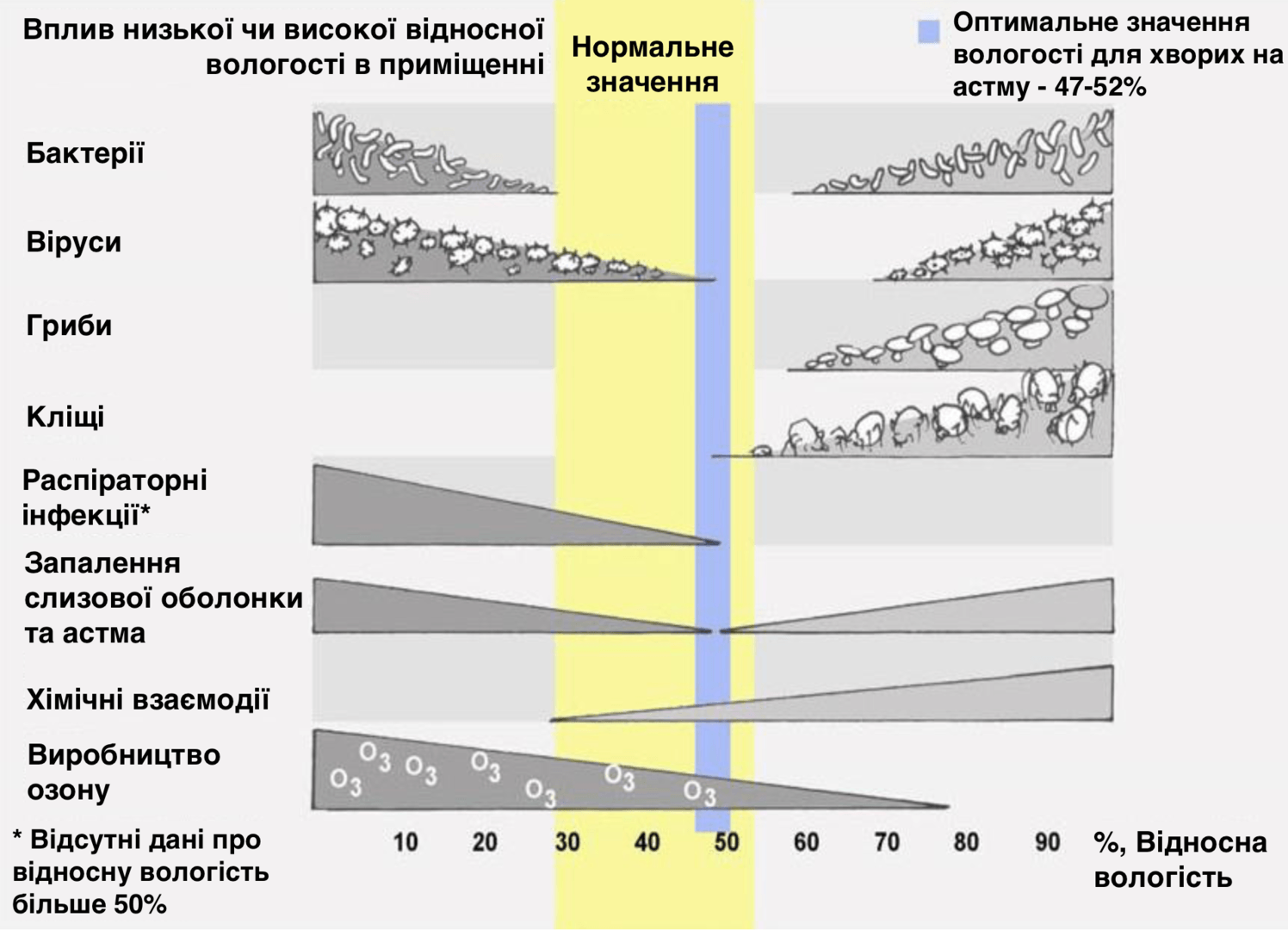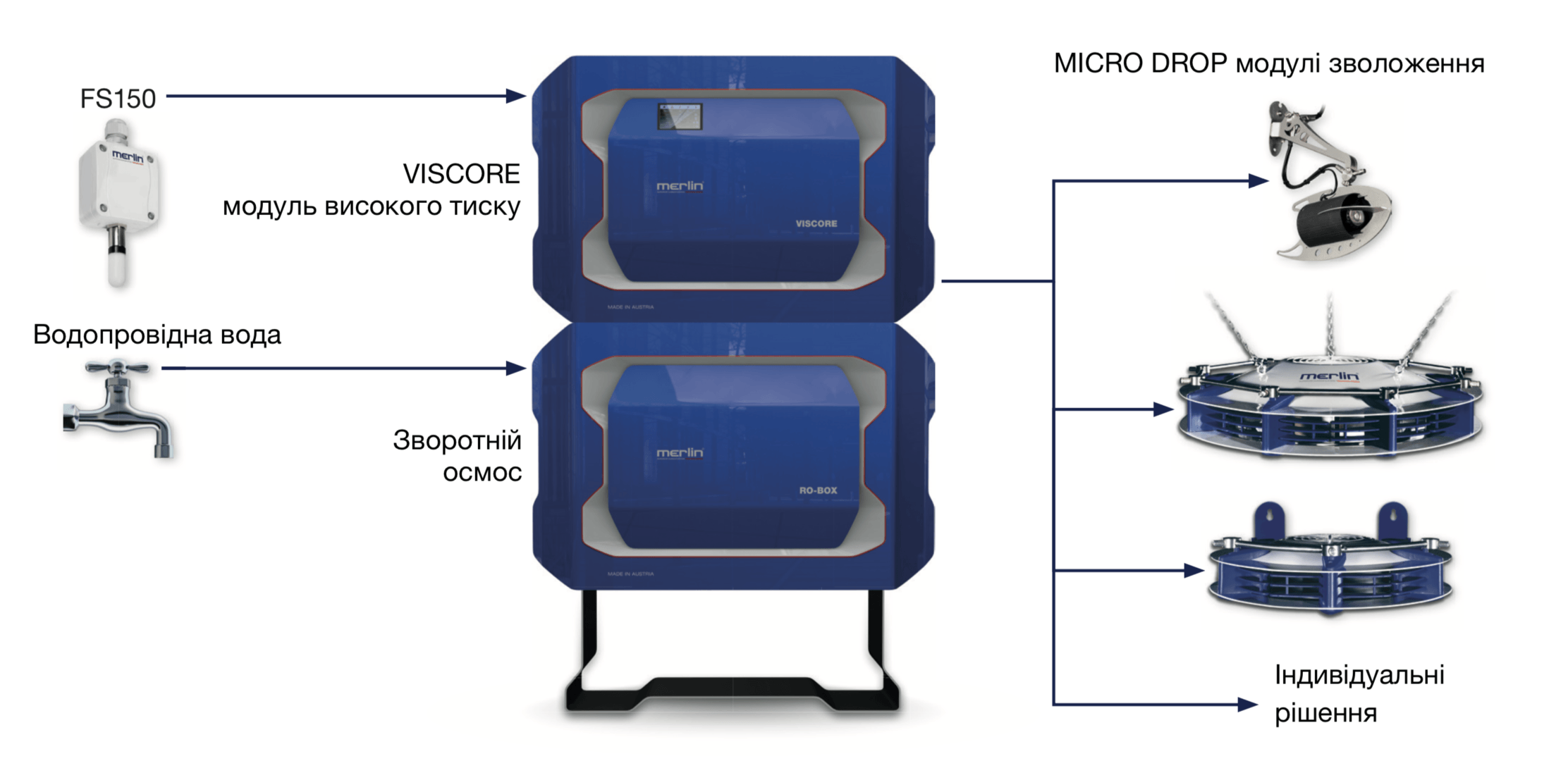Microclimate in a room that is perceived by the person as comfortable is a dominant condition for maintaining health and improving performance.
What microclimate parameters can be considered comfortable and suitably optimal?
The energy balance of a person determines both an excellent state of health and an indicator of labor productivity. The following external factors affect an individual's energy balance:
Humidity, along with its temperature is one of the main parameters of a comfortable microclimate. First of all, we trace the path of air inhaled by humans. Inhaling air through the nose, air travels through the airways and enters the lungs with the terminal organs, the so-called alveoli. The latter are covered with mucous membranes that constantly secrete mucus. Some of these mucous membranes have hairy processes (ciliated epithelium). Our nose, eyesight and trachea work on the principle of air conditioning, not only purifying what is obtained by inhaling the air, but also heating it in the case of cold outside air, and most importantly - humidifying it. In this case, dust particles that penetrate with the air are pressed against the mucous membranes and due to the flashing epithelium are mixed with the mucus and are removed. It is only as a result of such continuous wetting of the mucous membranes that the inhaled air is moistened to a state of saturation and heated to body temperature. But in the winter of the year, especially at outside temperatures below 0 ° C, this process is sometimes disturbed.
Considering a typical office, the temperature deviation during the day is 1 ... 2 ° C and 5% relative humidity. Necessary air exchange (according to sanitary and hygienic requirements) is realized through periodic ventilation through translucent enclosures. Workers most often complain of dryness in the nose and difficulty swallowing. As a result, there is a problem of absence from work due to illness, exacerbation usually occurs during the heating period.
In a room that is heated relative humidity ranges from 10% to 30%, in the evening and in the morning this figure decreases even more due to the low outside temperature. Inhaling human air with such low relative humidity causes unpleasant dryness of the respiratory mucous membranes. The condition is exacerbated if the work activity is related to continuous or frequent conversations. The first alarms, in particular, dryness around the nasopharynx, sometimes with painful irritation - are most often not taken seriously. Low relative humidity disrupts the function of the ciliated epithelium: mucus thickens and is unable to drain while retaining on the mucous membrane. In addition, the airways and lungs can stay healthy only with adequate volume of mucus and its timely removal. Due to this, all pathogens, as well as dust and other dirt remain in the respiratory tract and under certain conditions are able to penetrate the mucous membranes of the respiratory tract.

In industrialized countries, respiratory diseases are second only to cardiovascular diseases. Almost 90% of the population tolerate colds at least once a year. Unrecognized bacterial infection in good time causes loss of health for a considerable period of time (several years). With the possibility of maintaining the relative humidity of 40-60%, depending on the temperature and working conditions in the room, there is a simultaneous decrease in the number of germs in the air. Studies have shown that pneumococci at 50% humidity die less than 10 minutes, while at 20% or 80% can survive for more than two hours. Therefore, the greatest attention to the processes of humidification should be given in the winter (heating) period, even with high relative humidity. Because getting into the room air does not change its absolute wet content, unlike the relative humidity, which sharply decreases.
The company's range allows you to meet the need for office comfort of any complexity and with the use of various types of systems.
Installing humidifiers directly in the ventilation duct may be a simple and reliable solution for humidification in office buildings. Merlin® offers two systems that allow for this type of moisturizing. Unique Merlin® , Orbit Wing® system that seamlessly integrates with existing air conditioning and ventilation systems. The system in automatic mode provides effective moisturizing with minimal cost. The air is moistened with high-performance micro-drip nozzles inside the channel. It takes only 2.5 to 3 watts of energy to get 1 kg of moisture, which is 90% more economical than steam humidification. The efficiency is approximately 98%, almost without condensation. Another technically, but no less effective - installation of an ultrasonic humidifier in the duct. Such systems allow you to operate without condensation with the possibility of smooth regulation. Ultrasonic humidifiers are the easiest to use and require minimal maintenance.

An alternative to the channel humidification system may be the Merlin® ,Alpha and Viscore systems used for the unconditional humidification of the channel. the premises. In this case, the treated water is fed through the high pressure device to the humidity modules. The modules are suspended from the ceiling or mounted on walls or columns that spray water of drinkable quality using nozzles. Central control units use humidity sensors to monitor indoor humidity and regulate system start-up and shutdown times.

Another option of running an air humidification system in small offices is to install a direct evaporation humidifier installed in the ducts after the ventilation machine. The installation provides moisture by droplets by the method of natural evaporation without the formation of fog (without aerosols). It provides constant and optimal humidity - set in the range of 40-60% relative humidity. The evaporator with rotating slats is placed in a container to which the drinking water comes. Built-in UV disinfection devices guarantee the evaporation of only sterile water. Rotating slats with a percentage accuracy rake in moisture, directing it into the air.

Maintaining the right level of humidity is an extremely important task both to create comfortable conditions in the room and to ensure sanitary and hygienic requirements.
A person reacts sharply to a significant decrease in humidity, which causes the following symptoms:
- Dry mouth
- Inflammation of the eyes
- Irritation of the nasal sinuses
- Cracking of mucous membranes
- Increasing infectious diseases
- Increased risk of asthma attacks
- Chronic and joint pain
- Bleeding
- Reduced concentration and rapid fatigue
- Drying of furniture and decorative covering of wooden products
- Accumulation of static voltage charges
Also, insufficient humidity causes inflammation of the mucous membranes of the eyes in people who use contact lenses. Due to their hygroscopicity, they absorb moisture from the surface of the eye, so when the air is dried, the lens dries and deforms. By drying the surface of the eye, a viscous is formed, which causes the accumulation of bacteria that irritate the eyes.
The use of state-of-the-art and automated humidification systems will help to avoid the above problems and will increase the efficiency and health of office workers.
